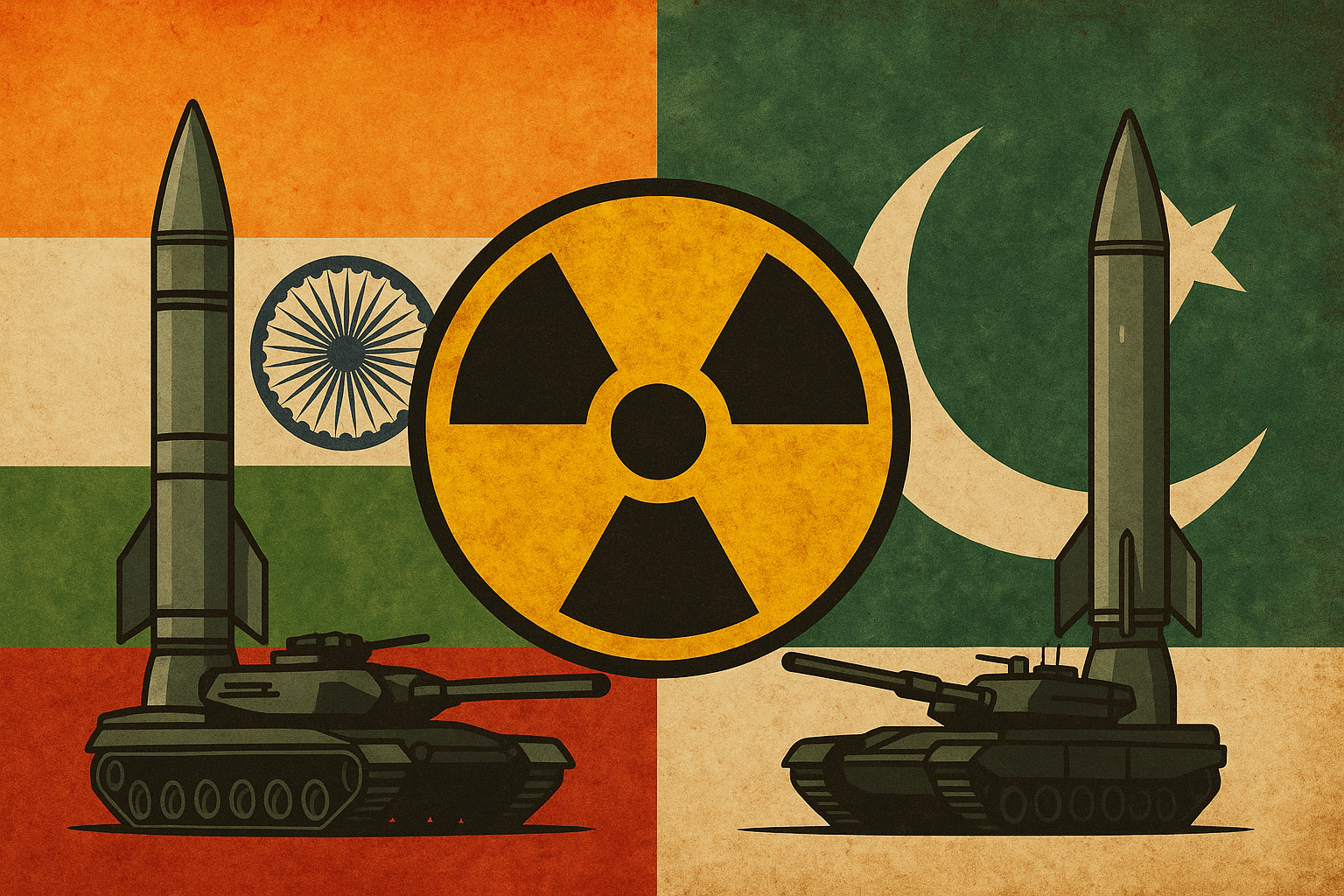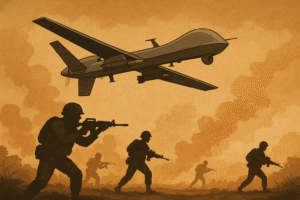Nuclear Stability, Conventional Instability: Rethinking Deterrence After the 2025 India–Pakistan Crisis

A symbolic image reflecting the paradox of nuclear deterrence and escalating conventional conflict during the India–Pakistan 2025 crisis.
India and Pakistan came perilously close to all-out war in May 2025, yet nuclear arsenals held back a full-fledged exchange. Instead, the conflict played out as a fierce conventional clash: for example, debris from an Indian fighter jet (shot down over Pampore, Kashmir) lay in a mosque courtyard after a dogfight, illustrating how rapidly a sub-nuclear skirmish can erupt under the nuclear shadow. This is a case of the stability–instability paradox: nuclear deterrence kept total war at bay, but encouraged risk-taking at lower levels.
As one analysis explains, when both sides have stable deterrence at the strategic, they assume crises “will not escalate to the nuclear level,” so “instability and conflict are likely to occur at lower levels”. In May 2025, India dramatically expanded its range of strikes (including deep into Pakistan’s Punjab province) under the assumption that Pakistan would not use nukes to retaliate. Similarly, Pakistan responded with conventional means and veiled nuclear signaling, treating the skirmish as a contained clash rather than an existential fight. As Belfer Center analysts note, the crisis “reveals… the alarming normalization of limited military action under the shadow of nuclear deterrence.”
Prospect theory helps explain why both capitals behaved more aggressively under pressure. By one formulation, decision-makers “accept greater risks to avoid losses than to achieve gains.” In practical terms, when India and Pakistan each faced a sense of losing face or suffering harm, they became more willing to gamble. In India’s case, the April Pahalgam terror attack – which killed over 25 civilians – created a strong loss frame.
Public outrage and nationalist politics pressured Prime Minister Modi’s government to act forcefully. Indeed, experts note Modi’s administration has long promised to be tougher on Pakistan; “having seen the failure of 2016 and 2019 strikes to stop terrorism,” Indian leaders judged “further escalation seemed logical”. As Washington analyst Michael Kugelman observes, Modi’s government “is very sensitive” to attacks on Hindus, and the Pahalgam killings of largely Hindu tourists “led to this especially robust Indian military response”. In short, India framed itself as reacting to a loss of security and prestige, which made risky retaliation seem acceptable.
Pakistan, for its part, also felt under threat and loss. Islamabad’s leaders viewed India’s strikes inside Pakistan as an affront to sovereignty. Pakistan pledged to retaliate “at a time, place and manner of its choosing to avenge the loss of innocent lives”, and its defense doctrine explicitly relies on “full-spectrum deterrence” – including tactical nukes – for “calibrated escalation” if threatened. Veteran U.S. analysts point out that Pakistan’s nuclear arsenal gives it a “ski helmet” effect: knowing India fears nuclear war, having nukes lets Pakistan “take bigger risks”. In May 2025, Islamabad behaved consistently with that mindset, moving beyond cozy deterrence cues to signal serious escalation readiness.
The May 2025 crisis starkly shows the gaps in deterrence. Nuclear weapons clearly prevented a full-scale war – no nuclear missiles were fired – but they did not stop the fighting. Terrorist violence and proxy warfare still occurred and both armies still struck across borders. India launched airstrikes and missile raids deep inside Pakistan, including in populous Punjab – something previously seen only in half-forgotten full wars. Pakistan shot down jets and shelled Indian bases in turn. In other words, each side continued to inflict punishment “beneath the nuclear threshold,” assuming the other would not go nuclear – exactly as the stability–instability paradox predicts.
But this conventional clash had dangerous blind spots. As Belfer analysts warn, the crisis is “a stark reminder that nuclear deterrence does not guarantee strategic stability”. Both armies used new technologies (drones, cyber, precision missiles) so that “the risk of miscalculation multiplies”. The commentary concludes grimly that with compressed geography and full-alert postures there is “virtually no escalatory buffer, no meaningful space to fight and contain conflict once thresholds are crossed”.
In practice, this means even limited steps (a cross-border strike or civilian casualty) could accidentally trigger an uncontrollable spiral. Indeed, India had long relied on limited attacks – Kashmir raids in 2016 and Balakot airstrikes in 2019 – hoping Pakistan would back down. That assumption appeared to hold until May 2025. The crisis therefore calls into question whether nuclear deterrence can truly be “credible” when conventional hostilities continue. As one analyst observed, India still “showed it’s willing to test what it calls Pakistan’s nuclear blackmail,” suggesting the old nuclear balance of fear may no longer contain Indian retaliation.
Moreover, the limits of deterrence were visible even in negotiations. The 1988 India-Pakistan pact banning attacks on nuclear facilities did hold – no nuclear sites were struck – but every other aspect of conflict was fair game. Indian leaders emphasized they struck only “terrorist infrastructure” and “no civilian population was affected,” while Pakistan insisted India’s actions were a warlike violation of sovereignty. Civilians did die on both sides. In short, nuclear deterrence may have imposed a mutually assured fear at the top, but it did not stop mutually assured mischief at lower levels. One former U.S. official bluntly calls the situation a “new and dangerous era” – a time when India feels less constrained by nuclear risk.
The May crisis makes clear that deterrence alone cannot deliver stable peace. Experts urge adding proactive crisis controls on top of nuclear weapons. For one thing, communication channels and off-ramps are essential. During the 2025 flare-up, the U.S. helped broker a ceasefire, but analysts stress this is only a temporary pause. As CSIS Nuclear Network notes that beyond simply halting combat, India and Pakistan need to use the ceasefire talks to develop new “off-ramps and confidence-building measures,” rather than waiting for the next catastrophe.
In practice this could mean regular dialogue, military hotlines, and routine exchanges of information to dispel surprise and misperception. (In fact, both sides do have hotlines and shared no-attack pacts, but the crisis showed these measures are insufficient on their own.) As Belfer experts argue, “breaking this cycle requires more than a ceasefire – it demands a rethinking of regional stability mechanisms.” That means clearly articulating each side’s red lines and rules of engagement. For example, both capitals could publicly clarify what level of attack on terrorist bases or military outposts might trigger what response, reducing dangerous ambiguity.
Other confidence-building steps could include revisiting tactical-nuclear limits. Pakistan’s use of small nuclear weapons (the Nasr missile) looms over any conventional fight; some analysts suggest exploring agreements to keep battlefield nukes off-limits, or to reinforce India’s no-first-use pledge, to reduce pressure on commanders. Finally, third-party involvement should not be ad hoc. The 2025 U.S. brokered ceasefire shows outside actors can help de-escalate, so Washington, Beijing or others might stand ready to mediate quickly in future flare-ups. In sum, to prevent another near-breakdown, the nuclear shadow must be complemented by active diplomacy and institutional safeguards – from agreed-upon crisis hotlines to new arms-control arrangements – so that deterrence truly does what it’s meant to do, rather than merely shifting conflict to the gray zone.



